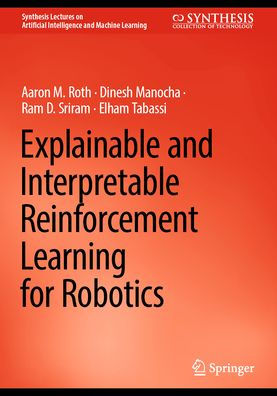
Explainable and Interpretable Reinforcement Learning for Robotics
114
Explainable and Interpretable Reinforcement Learning for Robotics
114Hardcover(2024)
-
PICK UP IN STORECheck Availability at Nearby Stores
Available within 2 business hours
Related collections and offers
Overview

Product Details
| ISBN-13: | 9783031475177 |
|---|---|
| Publisher: | Springer International Publishing |
| Publication date: | 03/20/2024 |
| Series: | Synthesis Lectures on Artificial Intelligence and Machine Learning |
| Edition description: | 2024 |
| Pages: | 114 |
| Product dimensions: | 6.61(w) x 9.45(h) x (d) |
About the Author
Ram D. Sriram is currently the Chief of the Software and Systems Division, Information Technology Laboratory, at the National Institute of Standards and Technology. Before joining the Software and Systems Division. Dr. Sriram was the leader of the Design and Process group in the Manufacturing Systems Integration Division, Manufacturing Engineering Laboratory, where he conducted research on standards for interoperability of computer-aided design systems. Prior to joining NIST, he was on the engineering faculty (1986-1994) at the Massachusetts Institute of Technology (MIT) and was instrumental in setting up the Intelligent Engineering Systems Laboratory. He has extensive experience in developing knowledge-based expert systems, natural language interfaces, machine learning, object-oriented software development, life-cycle product and process models, geometrical modelers, object-oriented databases for industrial applications, health care informatics, bioinformatics, and bioimaging. Dr. Sriram has co-authored or authored nearly 300 publications, including several books. He was a founding co-editor of the International Journal for AI in Engineering. Dr. Sriram received several awards including: an NSF’s Presidential Young Investigator Award (1989); ASME Design Automation Award (2011); ASME CIE Distinguished Service Award (2014); the Washington Academy of Sciences’ Distinguished Career in Engineering Sciences Award (2015); ASME CIE division’s Lifetime Achievement Award (2016); CMU CEE Lt. Col. Christopher Raible Distinguished Public Service Award (2018); IIT Madras Distinguished Alumnus Award (2021). He is a Fellow of AAIA, AIBME, ASME, AAAS, IEEE, IET, INCOSE, SMA, and Washington Academy of Sciences, a Distinguished Member (life) of ACM , a Senior Member (life) AAAI, and an Honorary Member of IISE. Dr. Sriram has a B.Tech. from IIT, Madras, India, and an M.S., and a Ph.D. from Carnegie Mellon University, Pittsburgh, USA.
Elham Tabassi is a Senior Research Scientist at the National Institute of Standards and Technology (NIST) and the Associate Director for Emerging Technologies in the Information Technology Laboratory (ITL). She also leads NIST’s Trustworthy and Responsible AI program that aims to cultivate trust in the design, development, and use of AI technologies. As the ITL’s Associate Director for Emerging Technologies, she assists NIST leadership and management at all levels in determining future strategic direction for research, development, standards, testing, and evaluation in the areas of emerging technologies such as artificial intelligence. She also coordinates interaction related to artificial intelligence with the U.S. research community, U.S. industrial community, international standards community, and other federal agencies; and provides leadership within NIST in the use of AI to solve scientific and engineering problems arising in measurement science and related use-inspired applications of AI. Dr. Tabassi has been working on various machine learning and computer vision research projects with applications in biometrics evaluation and standards since she joined NIST in 1999. She is a member of the National AI Resource Research Task Force, Vice-chair of OECD working party on AI Governance, Associate Editor of IEEE Transaction on Information Forensics and Security, and a Fellow of Washington Academy of Sciences. In 2023, TIME magazine named Elham Tabassi in its list of the 100 most influential people in AI.
Dinesh Manocha is a Distinguished University Professor at the University of Maryland. He is also the Paul Chrisman Iribe Professor of Computer Science and Electrical and Computer Engineering as well as the Phi Delta Theta/Matthew Mason Distinguished Professor Emeritus of Computer Science at Chapel Hill University of North Carolina. Dr. Mancha’s research focuses on AI, robotics, computer graphics, augmented/virtual reality, and scientific computing and has published more than 750 papers. He has supervised 48 Ph.D. dissertations, and his group has won 21 best paper awards at leading conferences. His group has developed many widely used software systems (with 2M+ downloads) and licensed them to more than 60 commercial vendors. He is an inventor of 17 patents, several of which have been licensed to industry. A Fellow of AAAI, AAAS, ACM, IEEE, NAI, and Sloan Foundation, Dr. Manocha is a ACM SIGGRAPH Academy Class member and Bézier Award recipient from Solid Modeling Association. He received the Distinguished Alumni Award from IIT Delhi and the Distinguished Career in Computer Science Award from Washington Academy of Sciences. He was also the co-founder of Impulsonic, a developer of physics-based audio simulation technologies, which Valve Inc acquired in November 2016. He is also a co-founder of Inception Robotics, Inc.
Table of Contents
Introduction.- Classification System.- Explainable Methods Organized by Category.- 4 Key Considerations and Resources.- Opportunities, Challenges, and Future Directions.
